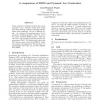Free Online Productivity Tools
i2Speak
i2Symbol
i2OCR
iTex2Img
iWeb2Print
iWeb2Shot
i2Type
iPdf2Split
iPdf2Merge
i2Bopomofo
i2Arabic
i2Style
i2Image
i2PDF
iLatex2Rtf
Sci2ools
107
click to vote
CP
2006
Springer
2006
Springer
Dynamic Lex Constraints
Many symmetry breaking methods have been proposed so far. Previous works have shown that these methods could be combined together under some conditions. We use a different angle : we compare the pruning power of two symmetry breaking methods. The first one is the rather classical SBDS method. The second one is the recently proposed dynamic lex constraints (DLC). We theoretically show that DLC prunes more nodes than SBDS if values are tried in increasing order. We also show experimentally that DLC can be more efficient than SBDS.
Artificial Intelligence | Classical Sbds Method | CP 2006 | Many Symmetry | Symmetry Breaking Methods |
Related Content
| Added | 20 Aug 2010 |
| Updated | 20 Aug 2010 |
| Type | Conference |
| Year | 2006 |
| Where | CP |
| Authors | Jean-François Puget |
Comments (0)

